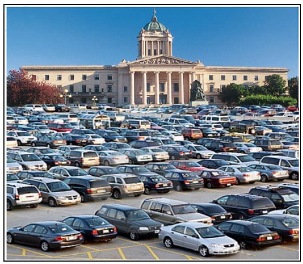HOW many times have we heard someone say that public auto insurance is less costly for drivers? Such a claim runs counter to common sense: after all, who really believes a government-owned monopoly can run a business enterprise better than the private sector in a competitive market? Now a new international study provides evidence that public auto insurance systems are actually among the worst performers within almost all measures of market quality, including the cost and affordability of auto insurance premiums.
Recent research published by The Fraser Institute compared auto insurance markets in 10 Canadian provinces, 50 U.S. states and the United Kingdom using publicly available data from 2002, the most recent year for which complete data was available across all jurisdictions.
Of the 61 jurisdictions examined, only British Columbia, Saskatchewan, Manitoba and Quebec have public auto insurance systems. In the three western provinces, the government-owned insurer occupies a near total monopoly of more than 95 per cent of market share, whereas in Quebec the corresponding figure is only 20 per cent.
A comparison of the cost and affordability of driver premiums showed that the three western public auto insurance systems performed badly relative to the group of 61.
The study compared the total amount of money spent on auto insurance premiums as a percentage of the total local economy (GDP) in each jurisdiction. By doing this, the study controlled for differences in the purchasing power of currencies or local prices for auto repairs that might produce unfair comparisons of the cost of auto insurance. The method also controlled for differences in driver risk profiles that are not captured by individual rate comparisons like those published by the defenders of public auto insurance.
The results showed that B.C., Manitoba and Saskatchewan ranked 60th, 52nd and 39th respectively out of 61. This means that as a percentage of local GDP in 2002, auto insurance premiums were lower in 59 other jurisdictions compared to B.C. In Manitoba, premiums were lower in 51 other jurisdictions.
Saskatchewan’s rank is notably better than the other two western public auto insurance provinces. But in 2002 the Saskatchewan auto insurance market was also in deficit because total claims exceeded total premiums. This means that even though the province’s premiums were lower than needed to cover costs, 38 other jurisdictions still did better than Saskatchewan in the overall cost comparison. The 10 least costly jurisdictions for auto insurance in 2002 included the No. 1-ranked U.K., eight U.S. states led by Illinois and Delaware, and 9th-ranked Alberta.
The study also compared total premiums paid for auto insurance as a percentage of total disposable income in each jurisdiction. This takes into account the affordability of premiums relative to the actual income that consumers have available to them after taxes. For instance, auto insurance premiums might be roughly equivalent across some jurisdictions in straight dollar comparisons, but consumers in a high tax jurisdiction have fewer available dollars with which to pay those premiums. Therefore, the price in effect feels much higher for consumers in the high-tax jurisdiction.
The results of this analysis showed that of the 61 jurisdictions studied, B.C., Saskatchewan and Manitoba had three of the four least affordable premium rates for auto insurance ranking 61st, 59th and 58th respectively.
After taxes, almost every other jurisdiction had more affordable auto insurance premiums than the three western public auto insurance provinces. The top 10 most affordable jurisdictions for auto insurance premiums were all U.S. states led by Illinois, Texas and Wisconsin. The U.K. finished middle of the pack at 27th of 61.
In fact, the study looked at 15 separate variables measuring the cost and pricing fairness of auto insurance premiums, the degree of consumer choice and the severity of the regulatory environment. The data shows that across all jurisdictions – whether public or private – more severely regulated auto insurance markets are linked with worse outcomes for consumers. But the evidence is even clearer that public monopoly auto insurance systems in particular are among the very worst performers, especially in terms of the concerns most often cited by consumers: cost and affordability.
Drivers in B.C., Saskatchewan and Manitoba should be asking why their governments have eliminated their choices as consumers, and forced them to buy auto insurance from a costly and unnecessary government-run monopoly. And drivers in other provinces should beware of misleading promises regarding the value of public auto insurance because the international evidence shows that competitive private sector markets are producing better results for consumers.
Brett Skinner is the director of Insurance Policy Research at The Fraser Institute and is a PhD candidate at the University of Western Ontario. He is the author of Auto Insurance Market Quality Index 2006: Annual Comparison of International Auto Insurance Markets.


